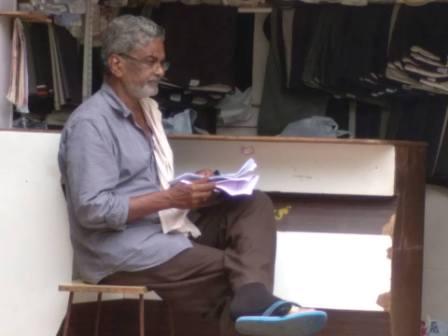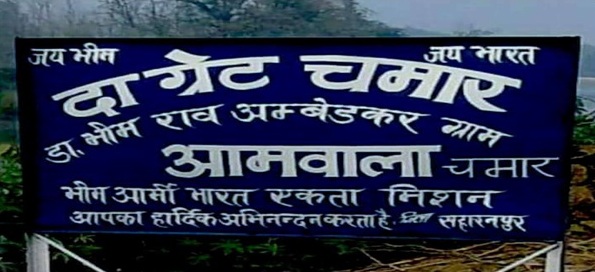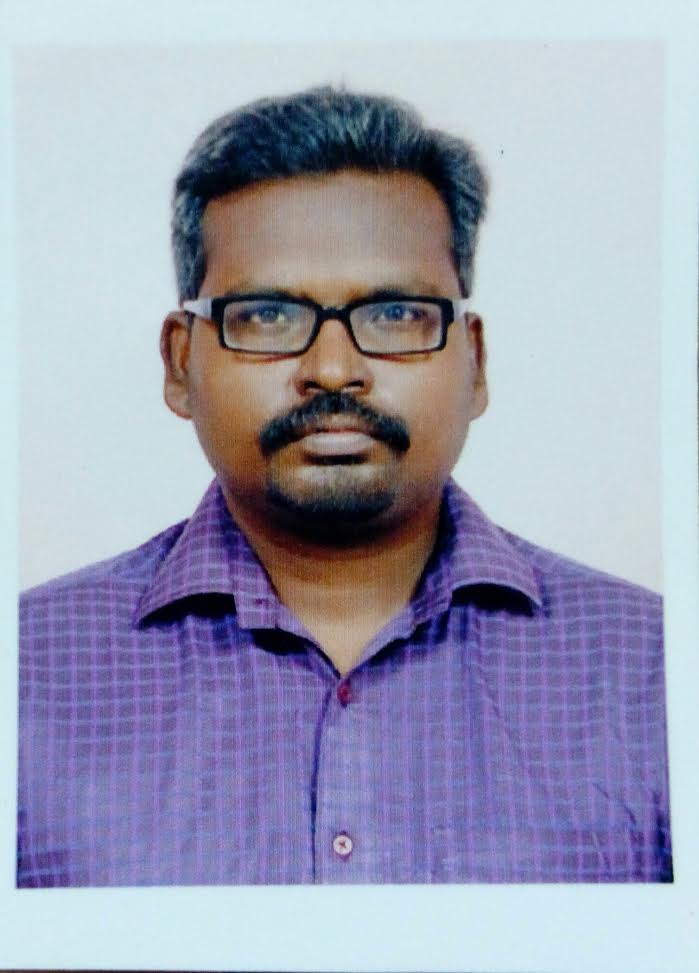Nilesh Kumar
 An article published in The Hindu (dated January 14, 2012) written by Harsh Mander is an eye opener for many of us who enjoy our private comfort zones. We feel safe and protected around our family, friends and acquaintances. There are many who do not have access to these secure environments and live in contested spaces. If the riots of 2008 (in Odisha) were not tragic enough, the massacre of Dalits and Adivasis that followed, by the upper caste Hindus was nothing but inhuman. Harsh Mander writes about ‘the systematic creation of hatred against religious minorities by Right wing organisations, rigorous planning of the carnage…often targeting women and girls’.
An article published in The Hindu (dated January 14, 2012) written by Harsh Mander is an eye opener for many of us who enjoy our private comfort zones. We feel safe and protected around our family, friends and acquaintances. There are many who do not have access to these secure environments and live in contested spaces. If the riots of 2008 (in Odisha) were not tragic enough, the massacre of Dalits and Adivasis that followed, by the upper caste Hindus was nothing but inhuman. Harsh Mander writes about ‘the systematic creation of hatred against religious minorities by Right wing organisations, rigorous planning of the carnage…often targeting women and girls’.
The rape of a nun in Kandhamal was reported in newspapers on 6th of January, 2012; the report also said that despite her being able to identify all the five culprits, the magistrate reported that the victim was able to identify only two accused persons. After her plea got rejected by the High court the case was transferred to the Cuttack court where it has met the same fate as thousands of other similar cases: that of being stuck.
The looting of Dalit and Adivasi land and resources by the upper caste Hindus compelled the Odisha government to build camps for the affected (Dalits and Adivasis). These camps are infamous, not only for their unimaginably bad living conditions but also because of their insensitive treatment of women and children. It is hard to imagine that for 5,000 people living in the camp, there are only two bathrooms, without any roof.
 The ongoing social and economic boycott has made many tribals lose their jobs as daily wage labourers in Kandhamal, due to which they have to migrate to other parts of the state and the country. Most tribals work as daily wage labourers which makes them dependent on other communities for employment; many of the tribals who are engaged in agricultural occupations and have their own lands are losing their lands as they have been forcibly displaced from their villages due to the violence, as Harsh Mander reports. Many of them are not allowed to enter the villages unless and until they convert to Hinduism; even their livestock was looted by the violent mobs. Many such incidences find a place in the article, giving us a picture of how people lost their jobs and are unable to find other livelihoods.
The ongoing social and economic boycott has made many tribals lose their jobs as daily wage labourers in Kandhamal, due to which they have to migrate to other parts of the state and the country. Most tribals work as daily wage labourers which makes them dependent on other communities for employment; many of the tribals who are engaged in agricultural occupations and have their own lands are losing their lands as they have been forcibly displaced from their villages due to the violence, as Harsh Mander reports. Many of them are not allowed to enter the villages unless and until they convert to Hinduism; even their livestock was looted by the violent mobs. Many such incidences find a place in the article, giving us a picture of how people lost their jobs and are unable to find other livelihoods.
As always, women are hit the hardest. The abysmal condition of toilets and inadequate sanitary supplies makes the conditions in the camps worse for them during menstruation. In many cases, women are given only 30 minutes to go out of these relief camps for relieving themselves and if they fail to return in stipulated time then they are punished by the CRPF personnel.
Sometimes the camps are prematurely closed, and people are driven out before they feel secure enough to return to their home land. It is important to scratch beneath the surface and question the premature closure of these camps.
The Hindu right wing is obsessed with the proselytization of tribals living in Odisha. They (tribals) are originally animists and have never followed Hinduism. The Hindutvawadis in the garb of ‘cultural revival’ (read as only ‘Hindu cultural’ revival) have been on a rampant conversion drive.
 The news of large scale conversions taking place in West Bengal was first reported by ‘compassdirect.org‘ on 13th May, 2011. It reported the forced conversion of sixteen tribal Christians to Hinduism. On 22nd April, at a purification ceremony in Chopra village, about 300 km from Kolkata, some animist tribals were forcibly converted to Hinduism by making them go through a fire ritual, forcing them to cleanse themselves by bathing and coercing them to chant Hindu prayers.
The news of large scale conversions taking place in West Bengal was first reported by ‘compassdirect.org‘ on 13th May, 2011. It reported the forced conversion of sixteen tribal Christians to Hinduism. On 22nd April, at a purification ceremony in Chopra village, about 300 km from Kolkata, some animist tribals were forcibly converted to Hinduism by making them go through a fire ritual, forcing them to cleanse themselves by bathing and coercing them to chant Hindu prayers.
These forced conversions also bring in the rather unpleasant caste dimension into play: like in which ‘jati’ would these converts be absorbed? Would they get the same respect as a Brahmin? The shastras come to our rescue and hasten to answer that to achieve the status of Brahmin one has to be born as a Brahmin. They cannot be Vaishyas for sure, as they have never been into commerce or business. What about Kshatriyas then? Yes, they are warriors in their own right as they have been fighting and resisting the system for long but would the Kshatriyas accept them as fellow Kshatriyas? Or Shudras? This is not clear from these proselytization processes. Another question is: why is the violence on Dalits growing only in BJP led states- right from riots in Gujarat, Karnataka church attacks to Odisha mass murders? In Madhya Pradesh, the cow slaughter act which was passed recently is also an insensitive act towards members of religious communities who are meat eaters. These facts are something to be scrutinized and analyzed by the people; such acts should surely lead people to overthrow the government.
 Recent news on IBN Live, dated Jan 23, states that thirty houses belonging to Dalits were set on fire by upper caste people at Lathor in Bolangir district in Odisha, they even blocked the roads to prevent entry of fire tenders and police personnel; they attacked the fire tenders, damaging their machinery and water pipes. Nor did they allow the police to enter the village when the houses were burning. After the arrest of more than forty people, the victims have been sent to temporary relief camps.
Recent news on IBN Live, dated Jan 23, states that thirty houses belonging to Dalits were set on fire by upper caste people at Lathor in Bolangir district in Odisha, they even blocked the roads to prevent entry of fire tenders and police personnel; they attacked the fire tenders, damaging their machinery and water pipes. Nor did they allow the police to enter the village when the houses were burning. After the arrest of more than forty people, the victims have been sent to temporary relief camps.
When Dalits start confronting the system, they face increased discrimination in the form of organized violence. Dalits are becoming educationally, economically and politically assertive, and some of them have also landed some jobs in government and the quasi-government sector. Many of these families are well educated and have started forming small organisations and voluntary associations where they are coming together to run welfare activities for the community. This has helped people from the villages and other community members to become more socially conscious.
These developments within Dalits are very visible to every one: children going to school or colleges, people getting jobs, Dalits prospering. This probably has caused hatred among the caste Hindus, as in Lathor. Some among the caste Hindus who are RSS followers are said to be behind the attacks.
Denial of Justice
These incidences of atrocities on Dalits are growing rapidly in Odisha and also in other parts of the country. Many scholars say that atrocities on Dalits are not a new phenomenon. It is gaining attention now because of political mobilization and awareness among them. They started theorising their pain. These incidences which are coming into the media glare are nothing but the result of the same.
 We can see the results of these assertions: more women are getting raped, houses are getting burned, and private property is being damaged. The adverse effects on children are psychological trauma, apart from causing disruption in their education. In most organized attacks, certificates, documents relating to their education and books are burned. Often it is the victims of these incidences, reported in various police stations and commissions, who also become targets of police harassment and trumped up cases.
We can see the results of these assertions: more women are getting raped, houses are getting burned, and private property is being damaged. The adverse effects on children are psychological trauma, apart from causing disruption in their education. In most organized attacks, certificates, documents relating to their education and books are burned. Often it is the victims of these incidences, reported in various police stations and commissions, who also become targets of police harassment and trumped up cases.
Often the police are acting as agents of the rich and powerful perpetrators during and after these incidences. There is unwillingness from administration to take any action against the culprits; the police acts as a mere spectator or offers excuses for inaction, in many instances. Some incidences are clearly cases of caste atrocities, but they are not booked under proper atrocity clauses and some perpetrators who are booked under atrocities act are released on bail.
A news report (dated Dec 9, 2011), which appeared in The Times of India talks about the National Commission for Minorities (NCM) expressing satisfaction over the measures taken by the Odisha government after reviewing the ‘rehabilitative aid and trial of criminal cases initiated in the aftermath of the violence’.
The National People’s Tribunal on Kandhamal, chaired by Justice A.P. Shah with Harsh Mander as one of the members, provides a different picture. Many of the testimonies presented before the tribunal say that many a times police refused to register FIRs. Of the 3,232 complaints filed by victims only 832 were registered by the police. Although more than 123 people were killed in the violence, only 26 murder cases were registered by the police.
 What happened with Sister Meena, who was gang raped and sexually assaulted during the riots, is illustrative: she was first dissuaded by the police from registering an FIR with regards to the crime, and when she insisted, she was prevented from writing details of the crime including the complicity of certain police officials. Many who spoke to the tribunal say that there is a complete failure on the part of the police to arrest perpetrators; though the names of the perpetrators were mentioned in the complaints, the police refused to take action against the perpetrators and protected them. People who went to lodge the complaints were harassed through lodging of false complaints against them and threats to arrest on false charges if they demanded accountability and continued pursuing justice.
What happened with Sister Meena, who was gang raped and sexually assaulted during the riots, is illustrative: she was first dissuaded by the police from registering an FIR with regards to the crime, and when she insisted, she was prevented from writing details of the crime including the complicity of certain police officials. Many who spoke to the tribunal say that there is a complete failure on the part of the police to arrest perpetrators; though the names of the perpetrators were mentioned in the complaints, the police refused to take action against the perpetrators and protected them. People who went to lodge the complaints were harassed through lodging of false complaints against them and threats to arrest on false charges if they demanded accountability and continued pursuing justice.
A similar report by MARG says that even police participated in the violence and investigations have been conducted in a biased and shoddy manner. Many people told the tribunal how they are hiding while pursuing the cases in courts, living in fear with no adequate protection from the police. Some of them spoke about how they had complained to the judges and the police about the threats and intimidation but didn’t receive any assistance.
A recent report by a fact finding team consisting of some young JNU, Jamia and DU students came up with similar kind of findings. Such responses and protests are being seen in many parts of the country after such incidences. Students of various Universities are protesting in different ways, but the overall degree of consciousness is rising across the country.
 The atrocities on Dalits and Adivasis in these regions will continue to grow in the future as a response to the rising awareness and politicization happening among Dalit and Adivasi movements. They will be paying a great price for this. This will go on till the caste divide among Scheduled Castes and other differences in Adivasis end, when there will be a sense of fraternity and brotherhood among all the Dalits and Adivasis, at least on the basis of the common oppression they are going through. If Odisha Dalits are suffering and Dalits of Maharashtra or Dalits from different parts of the country come on to the streets and protest in solidarity then there might be some chances of a wide movement happening. We can begin to see a future devoid of atrocities, if we are able to force the government and the oppressors to stop these atrocities against us, the Dalits and Adivasis.
The atrocities on Dalits and Adivasis in these regions will continue to grow in the future as a response to the rising awareness and politicization happening among Dalit and Adivasi movements. They will be paying a great price for this. This will go on till the caste divide among Scheduled Castes and other differences in Adivasis end, when there will be a sense of fraternity and brotherhood among all the Dalits and Adivasis, at least on the basis of the common oppression they are going through. If Odisha Dalits are suffering and Dalits of Maharashtra or Dalits from different parts of the country come on to the streets and protest in solidarity then there might be some chances of a wide movement happening. We can begin to see a future devoid of atrocities, if we are able to force the government and the oppressors to stop these atrocities against us, the Dalits and Adivasis.
Nilesh Kumar is doing M.Phil in Tata Institute of Social Sciences, Mumbai, and his main interest is to document the narratives and experiences of Discrimination which Dalit students face while pursuing Higher Education.
[Pictures from Kandhamal and Lathor, courtesy: Rediff News and Jadumanilion Boudha & Dhammachari Ratnakumar, Round Table India contributors]










